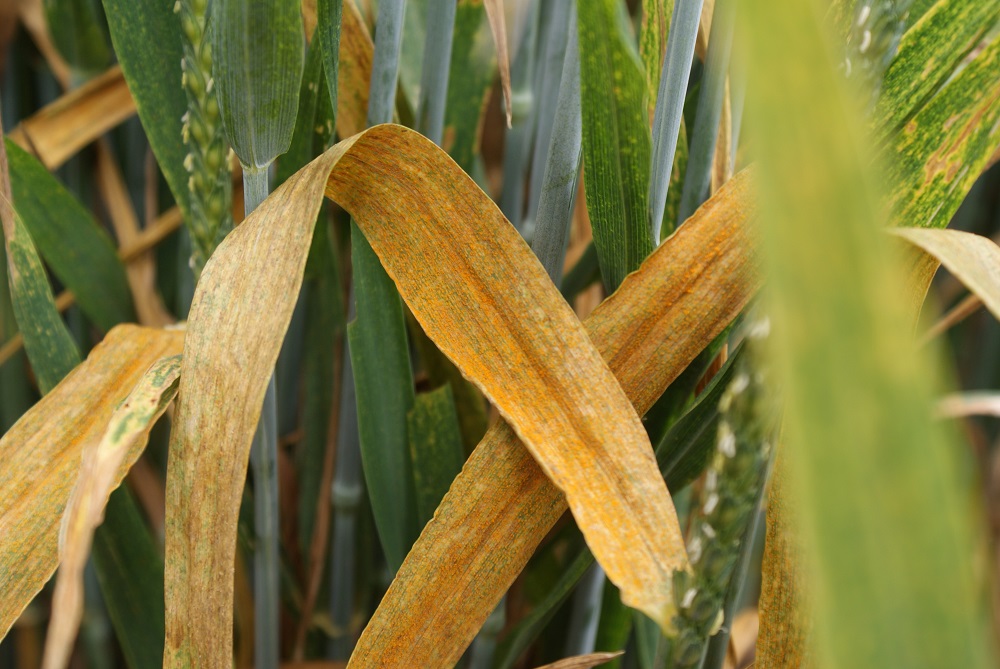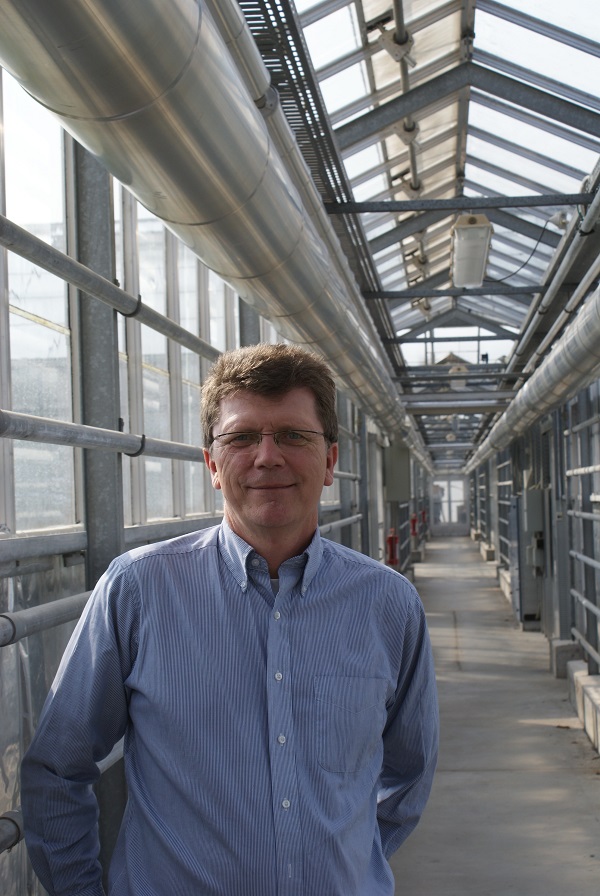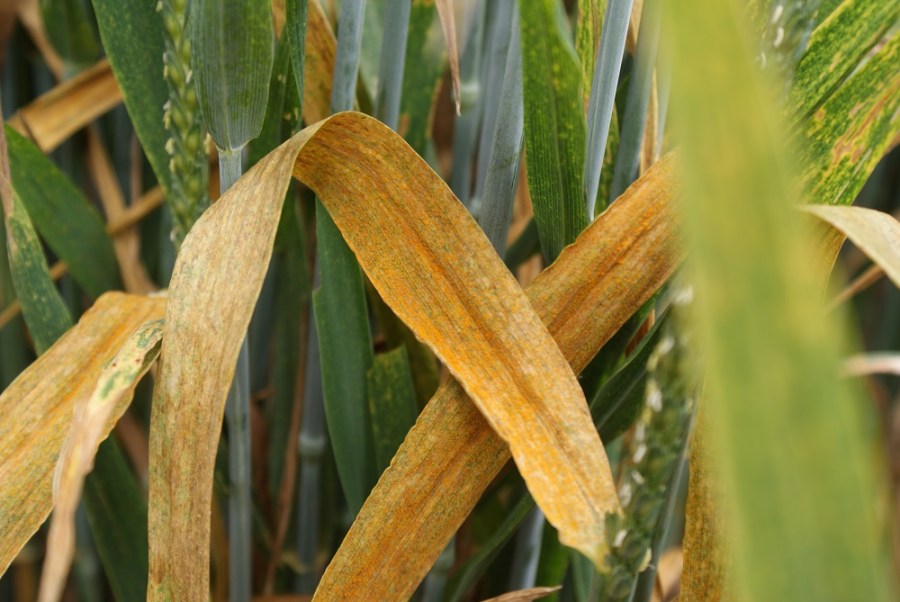
The arrival of the Warrior race of yellow rust in 2011 was a game-changer. CPM finds out how the pathogen is continuing to evolve and what that may mean to growers.
There’s so much genetic diversity out there, you can’t be entirely sure what you’re dealing with.
By Lucy de la Pasture
Yellow rust (Puccinia striiformis f.sp. tritici or PST) has gone from being a relatively simple pathogen to a very complex one – with a massive shift in terms of population genotypes and pathotypes in just a few years.
Fortunately for growers there’s no fungicide resistance, yet, so current chemistry is effective but the game is forever changing as the pathogen overcomes varietal resistances and new races emerge. The Warrior race came to the fore in 2011 but the latest buzz has been all about detection of the Kranich race in the UK during 2014.
Emerging picture
Last month, the UK Cereal Pathogen Virulence Survey (UKCPVS) reported their most recent findings from analysis

There was a massive change in yellow rust epidemiology when the Warrior and Kranich races emerged, says Mogens Hovmøller.
of samples of cereal diseases received during the 2015 season. Scientists from other European countries also gave their results and the emerging picture seems to imply that PST is going to continue to prove a challenging pathogen as populations become even more diverse. According to French work, some strains now appear to be able to adapt to regional climatic conditions, significant because it’s something that hasn’t been identified before in Europe.
Prof Mogens Hovmøller of the Global Rust Reference Centre at Aarhus University, Denmark, explains that until recently there were at least six distinct genetic groups of yellow rust worldwide, one of which was present mainly in Europe.
“The European group had low genetic diversity despite the presence of many races, which generally emerged by mutation of existing ones. That meant the races had a similar genetic background but different virulence.
“In Europe, there was a massive change in yellow rust epidemiology between 2010-2011 when the Warrior and Kranich races emerged. These are both non-European in origin, probably arriving by airborne spores over large areas, and they represent a completely new genetic package.
“The new yellow rust population has higher genetic diversity and within a year almost entirely replaced the old population of the pathogen. The Warrior race is genetically most similar to populations in the Himalayan area and the Kranich race is also similar, but less so,” he says.
To make matters more complicated, the new races of yellow rust, as well as being entirely different to the old European pathogens, contain large diversity within them. This means pathogens within the same race can be highly related in terms of genetics and pathology but have difference virulence on commercial varieties.
That’s a problem that UKCPVS’ Dr Sarah Holdgate is encountering with the Warrior race and has led to a reclassification within the group for 2016 to reflect their genetic sequencing data, provided by Dr Diane Saunders at the John Innes Centre, and their ability to cause disease.
“There are now three groups – Warrior 1 (pink), Warrior 3 (blue) and Warrior 4 (red) – replacing the old system of Warrior group 1-4 and Solstice,” she explains. A potentially confusing anomaly of the new system is that Warrior 4 (red), the main group in the UK representing 65% of the isolates tested in 2015, is avirulent or doesn’t cause disease in the variety Warrior.
One of the key findings was a pathotype within group 4, not previously observed in the UK. Samples were taken from ‘unusual’ sightings of yellow rust in Scotland, Essex and North Yorks, some of these sites were RL untreated trials.
“Pathotyping results revealed virulence to the genes Yr1, 2, 3, 4, 6, 7, 9, 17, 25 and 32, as well as virulence on varieties Spaldings Prolific, Robigus, Solstice, Cadenza, Apache,” explains Sarah Holdgate.
“It’s too early to tell if this new pathotype caused the high yellow rust levels but our adult plant tests this summer will help provide an answer. This shift in the pathogen population doesn’t necessarily indicate a change in race but it’s possible that this is what’s happening.”
Another group of isolates appears to be similar to the old Solstice race, dominant in the UK population before the Warrior-type races, based on seedling tests in 2015. However, the visual symptoms and genetic sequences suggest that these isolates aren’t the original Solstice race but are more closely resembling the Warrior race. However, further investigations are needed to resolve this issue.
Twist in the tale
This is clearly another twist in the tale but not altogether unexpected considering the results of genetic data provided by John Innes Centre. It confirms that some of the isolates collected since 2013 with the old Solstice pathotype should be assigned to the Warrior 3 (blue) subgroup, says Sarah Holdgate. “This group of isolates may also be behind some of the unusual yellow rust findings in 2015. Once again, we’ll investigate this in 2016 to provide a clearer picture.”
The subgroup, Warrior 1 (pink), closely related to the original Warrior race, was present at high levels in 2011 but has since decreased significantly to just 3% of isolates tested, another indication of the speed at which things are changing.
It’s evident that even within each of the Warrior subgroups, there’s a lot of variation, reflecting the highly diverse nature of the current yellow rust pathogen population, believes Sarah Holdgate. “As reported in 2015, this diversity means Warrior-type isolates affect varieties in different, and often unpredictable ways and close crop monitoring is essential. Reassuringly 19 out of the 36 current RL varieties were resistant to all isolates tested in adult plant trials last year,” she adds.
Susceptibility to all of the isolates tested was seen in KWS Kielder, Solstice, Gallant, the RL candidate variety Amplify and the control variety Hobbit. Moderate levels of disease were seen in Skyfall and Cubanita when challenged with all of the isolates tested.
There’s been a lot of noise about the Kranich race, detected in 2014 at a single site in Oxon. But in 2015, no new Kranich isolates were found in commercial crops.
“It’s probable that Kranich will be found again in the UK since it was found in Oxon, it’s likely to be present elsewhere but hasn’t been tested. A clearer picture is likely to emerge this summer as results from adult plant tests are reported,” says Sarah Holdgate.
The significance of Kranich race is that some of the varieties are more susceptible. New varieties, Spyder and Graham, both with excellent RL resistance ratings for yellow rust, show symptoms of infection when inoculated with the Kranich race. Other varieties, Myriad and Evolution, also showed some symptoms though at low levels.
The Kranich race is virulent on host resistant genes Yr1, 2, 3, 6, 7, 8, 9, 17, 25, 32 as well as varieties; Robigus, Solstice, Warrior, Ambition, KWS Sterling, Apache and Kranich. Notably Yr4 isn’t affected or Spaldings Prolific, a key determinant of the Warrior population.
So what does this all mean for growers and advisors? NIAB technical director, Bill Clark, stresses that the new strains we’re now seeing are exotic, originating from outside Europe. “It means yellow rust isn’t the same as it used to be and doesn’t behave in the same way. It’s set to become the most important disease we’re facing and needs to be taken seriously.”
The rapidly developing population means that wheat varieties in the field may not behave as expected according to their RL resistance ratings, he warns. Resistance ratings are likely to continue to change, with some varieties becoming more susceptible and others less so as the pathogen population continues to change.
“If cultivars with RL ratings for yellow rust of 8 or 9 start to show high levels of disease then a number of things could be happening. The variety may be seedling susceptible, meaning that the true adult plant resistance hasn’t come into effect yet. There may be a new race or a change in virulence or occasionally the variety isn’t the one you thought it was. In any case, it’s important to react to what you’re seeing in the field and control the disease.
“There’s a lot of yellow rust being reported in crops at the moment. Some may grow away from attack and in some cases, adult resistance may kick in later. But that’s not something you can afford to rely on happening because there’s so much genetic diversity out there, you can’t be entirely sure what specific yellow rust pathotypes you’re dealing with.”
Sarah Holdgate qualifies this adding, “There’s a good chance that the adult plant resistance may be more durable and stand up to lots of different races of the disease, both now and in the future. We’ve no way of predicting which will last or which will be overcome by the next race change, so we have to rely on monitoring to give us the most up-to-date information.”
In Denmark, the Global Rust Reference Centre are reporting two completely new races. One affects triticale and possibly some spring wheats. With virulence to Yr2, 6, 7, 8 and 9, the new triticale race has arrived with a high impact on triticale but not winter wheat. Similar to the pattern for Warrior, it appeared in many countries for the first time in the beginning of just a season.
Perhaps of more interest to UK growers is the discovery of a second unique pathotype with virulence to Yr2, 3, 6, 7, 8, 25 and 32, termed the Hereford race, which has been found in Sweden.
“The varieties affected are three of the most widely grown wheat varieties in Sweden – Hereford, Julius and Ellvis,” explains Mogens Hovmøller. “The significance to growers is that Hereford is a variety that has been widely used in many breeding programmes, even in the UK.”




